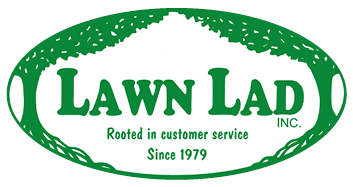One challenge for many Heights-area homeowners is the gradual infestation of creeping bentgrass in their lawn. Bentgrass is a low spreading turf type that does not blend well with turf that grows upright like blue, rye and fescue and when left unchecked has the potential to take over large lawn areas due to it’s spreading growth habit. The challenge has been how to deal with this tenacious ‘weed’…
Bentgrass by itself if managed properly creates a very pretty lawn. However, the required maintenance regiment for a bentgrass lawn makes it much less desirable than other cool season turf selections. Bentgrass has different cultural needs (e.g. low mowing height, thinning stolen growth/thatch), has different fertility and irrigation requirements and has an increased susceptibility to disease and possibly insects. This high maintenance turf is not desirable for the family on the go with a limited budget for lawn or yard care.
Creeping bentgrass (light green patches) is easy to identify
in early morning hours when the dew settles on the grass.
Overtime many lawns begin to look like a patchwork quilt due to the mixture of turf types and their relative condition during a particular season. Bentgrass often shows the symptoms of diseases such as snow-mold in the spring and dollar patch in the summer – causing unsightly brown patches. When the weather is right the lawn will look okay or even good, but it can go quickly from normal or healthy looking today to… “oh my gosh, what happened to my lawn?” the next day.
The reality is that the different maintenance requirements and susceptibility to disease creates a difference in appearance that cannot be readily accommodated with basic lawn care. The best bet for a consistent looking lawn is to remove the creeping bent grass all together.
Historical Control:
Historically there have been few options to selectively remove bentgrass from the home lawn. The challenge has been no effective weed control product that can selectively remove creeping bent grass from the desirable cool season turf types like you would a broad leaf weed.
Non-selective herbicides, like Round-up, will kill bent grass but will also kill any other grass plants that are sprayed. This is an effective option when replacing an entire lawn and where you want to kill the entire lawn.
However, selectively killing spots is not full proof because the application will not get every small sprig or individual creeping bentgrass plant in the lawn – meaning it will return as the super small unidentifiable patches grow and spread larger over time.
We also tried cutting out areas by hand or using a flame or torch to kill off patches of bentgrass. Similar to non-selective herbicide, this approach killed the patches of grass but did not get all of the bentgrass in the lawn which allowed it grow back in overtime, furthering frustration.
Today – Effective Herbicide Program for Control:
We have completed testing of a selective herbicide regimen and created an effective program to remove creeping bent grass from the home lawn. The program requires multiple late summer applications spaced at appropriate intervals to effectively control the bentgrass. Depending on the level of infestation, once the creeping bent grass has been controlled we can spot seed or perform a lawn renovation so the lawn fills in with the desirable turf type.
Creeping bentgrass patches show signs of stress and begin to
die off after one treatment from our program.
Timing:
The program is generally run from late July through early September prior to any necessary seeding or lawn renovation work. A spring program is an option but becomes more challenging with large renovations that do not have irrigation leading into the summer.
Looking Forward:
Creeping bent grass was used extensively when homes were built in the early to mid 1900’s before grass seed as we know it became readily available. Because of the preponderance of its use it will to some extent always be in the area.
Less than two weeks after the first application the tenacious
creeping bent grass plants are recovering – time for the next
applications before a lawn renovation is performed to
restore the lawn.
New lawns may still become infested with creeping bentgrass from neighboring lawns, animals or lawn care equipment that can help facilitate its migration. Before there was no guarantee that the creeping bent grass would not take over a lawn. Today however, with a control program the creeping bent grass can remain in check.
Our creeping bent grass control program will also manage other broad leaf weeds in the lawn.
Call today for a free consultation.

